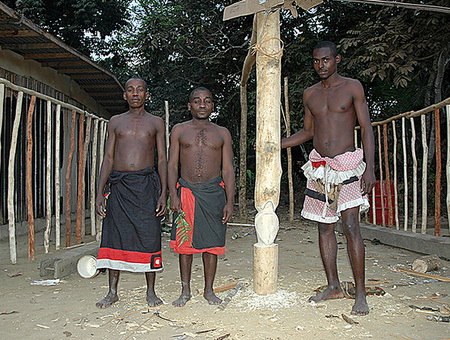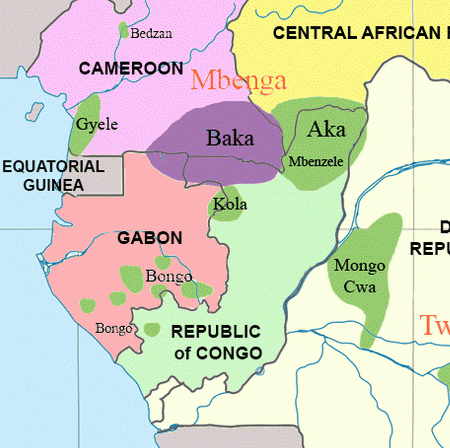

The Bongo people, or Babongo, are an agricultural people of Gabon in equatorial Africa who are known as "forest people" due to their recent foraging economy. Though considered Mbenga Pygmies, they are not particularly short. They are originators of the Bwiti religion, based on consumption of the intoxicating hallucinogenic iboga plant.
12.000 Babongo live in the forested area in Central Gabon. We find groups in Lope (Ogooué-Lolo), in Bakouyi (Mulundu) and in Koulamoutou, Pana and lboundji. Another major group of Babongo Pygmies is found between Akoula and Ngounié (Haut-Ogooué).
There is no one Bongo language. They speak the languages of their Bantu neighbors, with some dialectical differentiation due to their distinct culture and history; among these are Tsogo (the Babongo-Tsogho), Nzebi (the Babongo-Nzebi), West Téké (the Babongo-Iyaa), and Lumbu (the Babongo-Gama), and Myene (the Babongo-Akoa). Yasa in Gabon is reportedly spoken by "Pygmies"; Yasa-speakers speak a different language than their patrons, unlike any other group in Gabon apart from the Baka. The Barimba, Bagama, and Akoa live in the southern coastal provinces.

Bahuchet (2006) confirms three languages, each with dialectical differentiation from their non-Pygmy speakers: Tsogho in the central region (living with the Akele, Tsogo, Simba, Sango, Sira), and Teke and Kaning'i in the southeast (living among the Akele, Kaningi, Teke, Wumbu and the Obamba, Teke, respectively).
The Rimba variety of Massango, however, has recently (2010) reported to have a core of non-Niger–Congo words and therefore should be considered unclassified.
The Babongo have recently changed from being nomadic hunter-gatherers to settled villagers with subsistence agriculture supplemented by hunting. In the early 20th century they were fully nomadic and physically distinct from their Bantu neighbors, but by the mid 20th century they were starting to settle and to become physically indistinguishable. They have radio but not television in their small village communities and the few metal implements they possess come from the outside world. They are otherwise self-sufficient in their villages.
The Babongo have recently changed from being nomadic hunter-gatherers to settled villagers with subsistence agriculture supplemented by hunting. In the early 20th century they were fully nomadic and physically distinct from their Bantu neighbours, but by the mid-20th century they were starting to settle and to become physically indistinguishable. They have radio but not television in their small village communities and the few metal implements they possess come from the outside world.
The Babongo pygmies are the originators of the Bwiti religion and the use of iboga, said to have been discovered a thousand years ago. The Fang and Mitsogo peoples are also Bwiti practitioners. Although Christianity, one of the larger religions of the region, has been incorporated into Bwiti by some practitioners, a large part of the Bwiti do not follow this syncretic Bwiti trend. To this day there are still Catholic missionaries who are against Bwiti and its widespread practice throughout Gabon, but the president himself is a Bwiti initiate and iboga is recognized as a cultural heritage that is illegal to export without a permit.
In the Bwiti there are different types of rites depending on the ethnic group. The ceremonies are always led by a healer called N’ganga who is the spiritual leader of the community. Men’s rituals are led by a male N’ganga and women’s rituals by a female. There are separate temples (resembling small wooden huts) for men and women and the instruments used are also different; the main instrument being an 8-string Ngombi harp for women and Mongongo mouth-bow for men. Lots of percussion, hand clapping, and singing accompanies the ritual which has been said to help induce trance states. The temple has benches on the sides where members of the community, musicians from other villages, children, elders and healers sit whilst accompanying the rite of passage or healing process that takes 3-5 days in the case of men, and up to weeks for women. It is an incredibly delicate and complex process.
The Gabon forest is hot, humid, and the air is thick with insects. Malaria and dengi fever are endemic. This is the home of some of the world's most endangered species, from gorilla to forest elephant.Camps are made up of six to eight huts, housing up to 20 people at any one time. The traditional huts are called tudi, and made entirely from material gathered from the forest. The basic structure is a bent sapling, overlaid with flat wide leaves for waterproofing. When the Babongo lived a nomadic life moving through the forest, this is what they would have used - a hut like this takes just half a day to make. These days they also build huts of mud, to a design adopted from their neighbours the Mitsogo tribe.The men's hut is central to the Babongo's beliefs. Its structure stands for the human body, with a carved pole at the front representing the physical parts of man, the screened area at the back the spiritual.
Only initiated men can go here. The entrance is intentionally low, so that you bow your head as you enter.The Babongo have always been hunter-gatherers, and lived entirely from the forest. Hunting goes on all year round though it's generally easier in the rainy season, when the animals' whereabouts are more predictable. It's generally the men who hunt, and tactics differ across Gabon. In Lastoursville and Lebamba, for example, men and women together hunt communally with nets.Small game are trapped using wire snares. Bows and arrows are still used for larger prey, the arrows tipped with poison from seed pods gathered in the forest then pounded to a fine paste.
But these days the Babongo also hunt with guns, often loaned (with bullets) from Bantu neighbours in return for a portion of the valuable bush meat they catch. That includes gorilla, and elephant if it can be found.It's the women who grow maize, manioc and potatoes in small patches cleared from the forest. With the children they forage for food including crabs, a real delicacy, and catch armadillos by smoking them out of their burrows. As for many traditional hunter-gatherers, just three to four hours' work a day can often provide for basic needs. The rest of the time is spent just hanging out, playing with the children, grooming each other, telling stories, smoking and sleeping.
The Babongo believe they were the first people on earth. They share the forest with the Macoi, ambivalent spirit figures at once malevolent and benign. Drumming calls them from the forest, and they must be appeased at every turn - there's a ritual for every action, and countless forms of ceremony.When a person dies, for instance, the Babongo believe their spirit will linger in the village and cause harm.
The village must be cleansed through drumming, dancing and ritual. The women wash the body indoors and wrap it in a cloth. Then the men carry it to the graveyard in the forest for burial. The women paint their faces white with kaolin to symbolise purification, and dance and sing to put the dead person's spirit to rest. After three days and three nights of mourning, the funeral is declared over.The Babongo are surrounded by Bantu-speaking people, many of whom regard them as little better than animals. They are generally independent of formal authority: without papers, they keep their own traditions and decision-making structures. They may have the same civil rights as other Gabonese, but have played little part in politics.
The Babongo have a powerful reputation as sorcerers, and inspire awe in the Bantu for their knowledge of the forest. At the heart of this status is their knowledge of Iboga, a powerful hallucinogenic plant central to the Babongos' beliefs.The Babongo follow Bwiti, an animistic religion based on a belief in spirits which started in the forests thousands of years ago.
More recently Bwiti, influenced in curious ways by Christianity, has become one of Gabon's official religions - there are Bwiti churches, ceremonies and initiations in the capital, Libreville, and the first President was an initiate. In the city, the Bwiti drug Iboga is taken almost as Catholics take the host at Mass, and festivals follow the Christian calendar. But out in the forest, the original form of the religion is still practiced, in all its potency.The Babongo cultivate the drug Iboga for their ceremonies, and worship it as the source of spiritual knowledge. Some Bwiti scholars believe it is the Tree of Knowledge from the Garden of Eden. It comes from the bitter root of the Iboga tree, and is a powerful psycho-active drug -something like LSD, mescaline or amphetamines.
Taking Iboga brings a sense of anxiety, extreme apprehension and visual hallucinations -effects which can be made stronger by darkness, ambience and suggestion. It makes you violently sick, can lead to a state of lethargy lasting four to five days and, in extreme doses, it can kill.When Bwiti shamans eat Iboga, they are granted the power to see the future, heal the sick and speak with the dead. The Babongo use it as astimulant before hunting and during initiation ceremonies.
They believe that Iboga frees your soul to leave your body and go on a great journey,to speak with the spirits of animals and plants.The three-day initiation ceremony is used for spiritual or personal development, and to become a man. First the initiate eats the sliced root of the Iboga tree over a period of hours, monitored by his Bwiti father, and the visions begin. The Iboga allows him to see into his true self and vividly revisit the consequences of his past actions.
After 24 hours of this, the initiate is taken to the river by the men. They lift him through a construction of twigs shaped like a vulva suspended over the water, then wash him with water soaked with leaves. The men pull a sapling of the sacred matombi tree from the forest, and plant it outside the Bwiti temple - it represents the initiate as a child. Throughout the day the elders feed him small pieces of Iboga, and the whole village perform, dancing in vivid costumes, in a way designed to bring on further hallucinations.
In the last phase, the initiate is called upon to see the Bwiti visions. Fire dancers sprint the length of the village to entice the Macoi spirits fromthe darkness of the forest. The initiate must tell the elders what he has seen; this is sacred knowledge, known only to them, and through it hebecomes a man. The villagers meanwhile plant a forest around the matombi tree, to represent the problems to be faced in adult life.
Together,the men break up the trees branch by branch to symbolise the removal of all his problems. As well as influencing religious belief across Gabon, Iboga is also of increasing interest to Western medicine. One of its active ingredients,ibogain, has been used to treat heroin addicts, alcoholics and people who have been traumatised in childhood. Advocates say its particular powerful effects allow those who take it to move on from their previous lives and habits.
Sources: